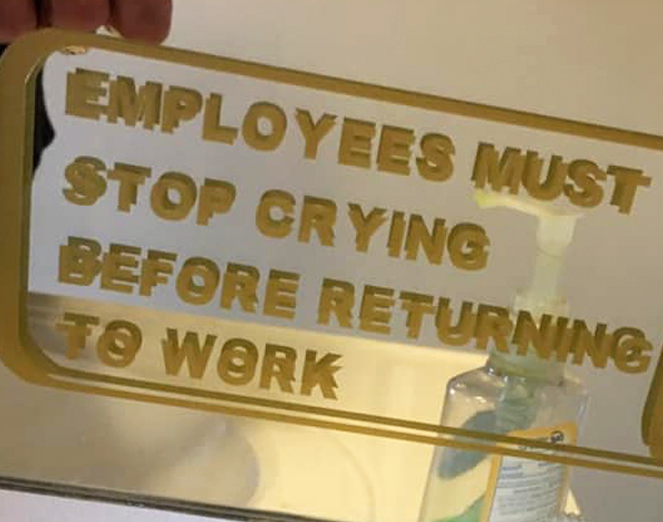

Chaotic Good: Donate it to food pantries and soup kitchens.
Chaotic evil: Dump it on the steps of the capitol building and build a giant ground beef Mitch McTurtle.


Chaotic Good: Donate it to food pantries and soup kitchens.
Chaotic evil: Dump it on the steps of the capitol building and build a giant ground beef Mitch McTurtle.


Yes, it was a clusterfuck, but
not on the leveleven larger than it was made out.
FTFY. Uvalde was a complete capitulation in regards to training, leadership decisions, and execution.
I already had you tagged as “Okay boomer” for some reason, and I guess that tracks with someone who would downplay how fucking atrocious the Uvalde police response was. Every single cop on the Uvalde police force deserved prison time for their outright complicity in the shooter’s murders.


Also, you totally glossed over the fact that Plex is simply easier for non-savvy people to set up. Plex provides a unified login experience similar to major streaming services, which Jellyfin simply can’t provide; If your mother-in-law can figure out how to log into Netflix on her TV, she can figure out how to log into Plex too.
And the unfortunate truth is that Plex’s remote access is much easier for 90% of users to figure out. It doesn’t require VPNs or reverse proxies at all. You just forward a port and anyone with access can easily see your server. But my MIL’s TV doesn’t even have access to a Jellyfin app without sideloading. Not to mention the fact that I’d need to walk her through actually setting the app up once it is installed, because there is no unified system for logging in. And if I’m not using a reverse proxy for my Jellyfin server, then I also need to walk her through setting up Tailscale, assuming her TV is even capable of using it at all.
Any single one of those hurdles would make Jellyfin a non-starter if I want to walk my MIL through the setup over the phone, and they’re all currently present. And some of them will never be fixed, by design. For instance, the lack of a unified login page is by design, because a unified login would require a centralized server for the app to phone home too. That centralization is exactly what Jellyfin was made to rebel against, so it’s a problem that will never be “solved”; It is seen by the devs and FOSS enthusiasts as a feature, not an issue.
From a FOSS perspective, Jellyfin is a modern marvel. But it’s definitely not at the same level as Plex when you compare ease of setup or remote access. Jellyfin is fine if you’re just using it locally, or are willing to run Tailscale to connect back to your home network. But if you’re looking for true seamless remote access and need to consider the mother-in-law factor, then Plex is hard to beat.


Yeah, exactly. First world was allied with the US. Second world was allied with the soviets. Third world was basically everyone else, and was largely considered irrelevant to the Cold War. That’s why “third world” became a signifier of undeveloped countries; If a country wasn’t part of the Cold War, it was likely because they didn’t have enough developed resources or manpower to be considered a war asset. If they were developed enough to contribute, one of the two sides would have already been working on recruiting them to the war.
It depends on which app you’re using. Voyager displays it out to 30 days, IIRC. But I think you can also configure that somewhere in the settings. I recently made this account after being here for over a year, so it’s amusing seeing the baby face next to my own comments.


If you do, I’d love to seed it. I’ve been looking for good copies of this for a while.


I have struggled to find good downloads for a lot of the older stuff. Looney Tunes and Tom & Jerry both come to mind; I’d love to have them on my server, but haven’t had the time to drive all the way to my parents’ place to get my old DVDs to rip. And even if I did get the DVDs, there’s a non-zero chance that they’re rotted. So I tried downloading them, but finding properly seeded torrents for content that old has been a struggle.


Blizzard is bad about this with WoW too. A lot of the content is only available as launch-day cinematics, and is vaulted once the expansion has launched. Getting the full plot for WoW as a new player is basically impossible, because so much of the game has been hidden from players.
It’s to create FOMO, and keep players active. If players know they can access content whenever they want, there’s no incentive for them to log in right now.


This is the worst way to go about doing it, because you should never assume a drawing is made to scale unless it is specifically marked as such. A protractor would be useless if the drawing isn’t to scale. Generally speaking, if a problem isn’t drawn to scale, it’s because all of the info you need to solve it is already present in the drawing. You don’t need to bust out the protractor to measure angles, because the angles can either be calculated from the available info, or aren’t needed in the first place.


I was pleasantly surprised by New Dawn. I had some big complaints about 5, so I initially assumed New Dawn (being a direct sequel to 5) was going to be more of the same. It was an interesting take on the series’ formula.


Mozilla could remain funded if they stopped doing things like paying the CEO seven million dollars per year while laying off employees. If Mozilla dies, it will 100% be because of corporate greed.


They’d just wait for you to inevitably come back to the states to visit; Regardless of your personal feelings on nationality, everyone has parents who will get old and sick eventually, and chances are very good that you’ll come back to visit them or to settle their estate afterwards.


It’s way worse than that; You have to pay income tax on your entire net worth when you renounce your citizenship. Basically, they say that when you renounce your citizenship, all of your assets are considered “sold” so you need to pay tax on it. The US also requires you to keep paying income taxes for a decade after you have renounced your citizenship. There was a big push around the 2008 crash, where congress became concerned that people would renounce their citizenship to dodge taxes. So they started making laws that required taxes to be paid even after expatriating.
Imagine moving to Germany and renouncing your citizenship, and you’re still paying income tax in America, for the income you made while in Germany.


Blockchain is a ledger, not a database.


That’s just tribalism in general. Humans are tribal by nature as a survival mechanism. In modern culture, that manifests as behaviors like being a rabid sports fan.
I think it’s a joke about physicists not understanding tolerances.
I remember hearing an old story about a company buying signs from a contractor. The contractor produced all kinds of things, so it was fairly straightforward to send them the CAD file and stop worrying about it. One manager did an audit, and realized they were paying hundreds of dollars each for these basic signs. They weren’t fancy or anything, and were just signs throughout the facility that got updated regularly. So why the hell were they paying so much for what should have been a simple print job?
After some investigating, the manager discovered it was because the engineer who did the original design for the signs forgot to change their default tolerances from 3/1000 of an inch. The contractor was busting out calipers and meticulously measuring the spacing and sizing on each letter before it shipped out the door.